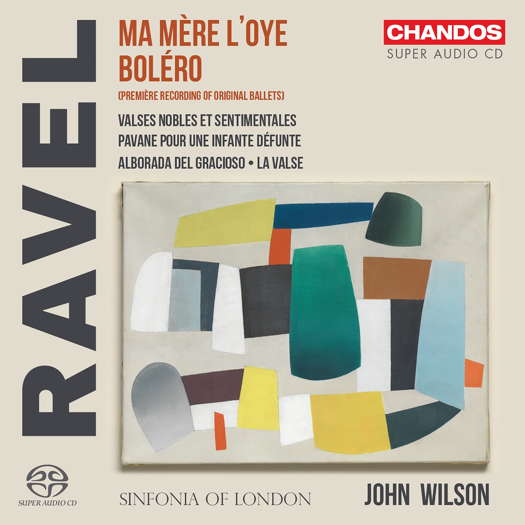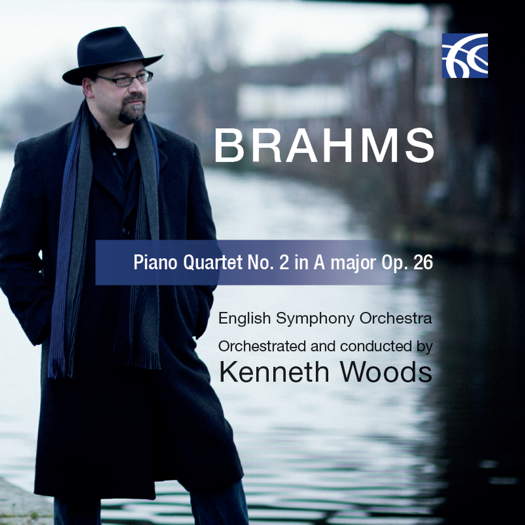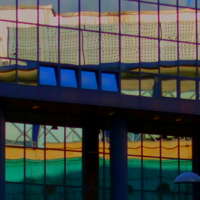- Britten: The Turn of the Screw
- Raymond Leppard
- Violetta
- Leonard Slatkin
- Purcell: King Arthur
- Turkish Cypriot
- Idris Sardi
- Cecilia McDowall: Century Dances

A Magical Touch with Orchestral Colours
Music by Ravel, heard by NATALIE ARTEMAS-POLAK
'John Wilson and the Sinfonia of London's superb disc is a joy to listen to, and the sound quality is crisp and clear.'
This new disc is a delightful contribution from John Wilson and the Sinfonia of London for lovers of Ravel's music and is particularly good for those who are not familiar enough with the master's best-loved orchestral works and transcriptions. Of extra interest is the fact that this CD features the premiere recordings of the original versions of Ma Mère L'Oye and Boléro, making this disc a collector's must-have.
The overall theme running through the disc is dance—waltz, ballet, pavane, bolero. All the featured pieces except for Boléro and La Valse began life as works for piano.
The disc opens with La Valse as an appetising invitation in honour of the Viennese waltz. Described by Ravel as a 'dance poem', it was choreographed as a ballet by (among others) Bronislava Nijinska, who also choreographed Boléro a year earlier. Wilson and the Sinfonia bring the character of the Viennese waltz to life, superbly contrasting the sections of the dream-like atmosphere with the moments where the waltz surges forward into the clear daylight, and one can't help but visualize a ballroom filled with swirling dancers.
Listen — Ravel: La Valse
(track 1, 1:37-2:34) ℗ 2022 Chandos Records Ltd :
Ma Mère L'Oye (Mother Goose) is one of the featured ballets in its original form, although this work was initially a piano suite for four hands depicting five fairy tales. Ravel later orchestrated and expanded it using an extra movement plus interludes to create a children's ballet in 1912. The sections on this CD are divided into a Prelude, five tableaux, and a final section labelled as an apothéose, which is the 'Fairy Garden'. (This is sometimes referred to as the sixth tableau.) Although beautifully interpreted throughout with stunning technique, there are moments of sheer emotion of great potential which are not quite given their due; more use could have been made of rubato, ritardando, crescendo/decrescendo at certain spots that would have added just that bit extra degree of feeling.
Another of several works on this disc which began life as piano pieces is the suite Valses Nobles et Sentimentales, named after Schubert's Valses Nobles Op 77 and Valses Sentimentales Op 50. This work of 1911 was orchestrated by Ravel a year later as music for the ballet Adélaïde, ou Le langage des fleurs. Although there is something special about the percussive nature of the piano which makes these waltzes so satisfying for that medium, here we have another chance to hear Ravel's magical orchestral colours and his genius for combining timbres. The work is performed with great sensitivity regarding the minute details in the score, and there is something especially touching about the Epilogue with its ghostly allusions to motifs from the waltzes we've just heard. Were the waltzes real, or were we dreaming ...?
Listen — Ravel: Epilogue (Valses Nobles et Sentimentales)
(track 18, 0:00-0:57) ℗ 2022 Chandos Records Ltd :
Ravel completed Miroirs, a suite of five pieces for piano, in 1905. Over a decade later at the request of Sergei Diaghilev, he orchestrated one of them, Alborada del gracioso, for the Ballets Russes. Here we have a sample of Ravel's enthusiasm for Spanish culture and music: his choice of the alborada, a festive morning dance, which starts off with its traditional rhythm as well as clever use of the harp and string pizzicato to allude to the sound of guitars.
Listen — Ravel: Alborada del gracioso
(track 9, 0:00-0:50) ℗ 2022 Chandos Records Ltd :
A traditional double-reed folk instrument is also associated with the alborada, and Ravel emphasizes this timbre in the pensive middle section of this short work in A-B-A form. Castanets and tambourines add to the unmistakable Spanish flavour. Wilson and the Sinfonia bring out all the passion and contrasts beautifully; the technique of playing is superlative, and it's difficult to listen to this track only once before moving on.
Pavane pour une infante défunte also began as a piano work in 1899, composed while Ravel was studying at the Paris Conservatoire under Fauré; his orchestral version was published in 1910. It is positioned perfectly here on this disc between the vivacious Alborada and the swirling Valses Nobles et Sentimentales as an oasis of calm and beauty. It is the second pavane on this disc, the first being 'Pavane de la belle' (Ma Mère L'Oye); traditionally, it is a slow, processional dance. For a gentler effect, Ravel pares down his orchestra to two flutes, one oboe, two clarinets, two bassoons, two horns, harp, and strings. And like the Alborada, this too is a miniature work in ternary form. The orchestra manages a lovely balance between restraint and great feeling; forte in this work — as rare as it is — somehow differs in nature from the same dynamic in other pieces.
Listen — Ravel: Pavane pour une infante défunte
(track 10, 5:23-6:06) ℗ 2022 Chandos Records Ltd :
As La Valse was our invitation to enter the world of the Sinfonia's new Ravel disc, what better way to end than with what many consider to be Ravel's best: Boléro, the single-movement work from his late period, originally a ballet commissioned by the Russian actress and dancer, Ida Rubinstein. The performance has a passionate quality to it as the crescendo slowly increases, and if anyone is not familiar with Ravel's genius for combining orchestral colours, this is the work to hear first. The dance character is, of course, carried throughout by the insistent rhythm, first heard by the antiphonal snare drums. The tempo accelerates slightly at a certain point later in the work giving the unwanted feeling of rushing, and the theme and the underpinning rhythm are momentarily out of synch. But these are almost undetectable. Overall control is regained once more, and the ending is supremely exciting.
Listen — Ravel: Boléro
(track 19, 13:57-14:34) ℗ 2022 Chandos Records Ltd :
John Wilson and the Sinfonia of London's superb disc is a joy to listen to, and the sound quality is crisp and clear. These particular choices of works are highly recommended for those who want to learn more about Ravel's magical touch with orchestral colours. Collectors of his music who don't have the original versions of the two ballets would do well to consider this unique new CD.
Copyright © 30 January 2022
Natalie Artemas-Polak,
Toronto, Canada

CD INFORMATION - RAVEL: ORCHESTRAL WORKS




